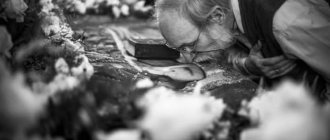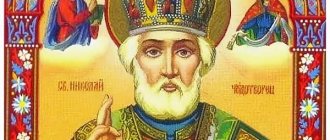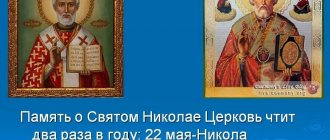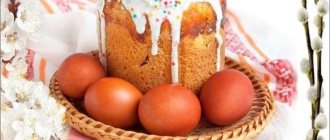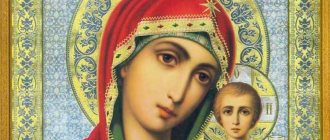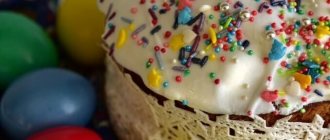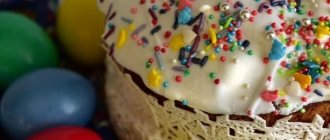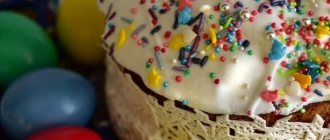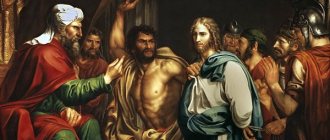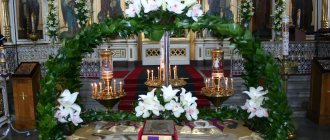Lazarus Saturday (Resurrection of Righteous Lazarus) is a solemn holiday celebrated on Saturday of the sixth week of Lent. The holiday is mobile, i.e. depends on the date of Easter. On this day, the Church remembers the miracle of Christ’s resurrection of righteous Lazarus four days after his death (John 11:1–45). Lazarus Saturday precedes the Feast of the Entry of the Lord into Jerusalem.
What is Lazarus Saturday
Lazarus Saturday, or Palm Saturday, is the Saturday of the sixth week of Lent. This week is also called Vai Week (“Vai” is a palm branch (obsolete church)), or Palm Week. On this day we remember the miracle of the resurrection of righteous Lazarus.
In the church calendar, Lazarus Saturday and the Entry of the Lord into Jerusalem (Palm Sunday) are celebrated on adjacent days: Saturday and Sunday. It is interesting that the liturgical time does not coincide with the historical one: the resurrection of Lazarus occurred a month or two before the Entry of the Lord into Jerusalem.
Now these two holidays are inextricably linked. They precede the events of Holy Week: the betrayal of Christ by Judas, suffering, crucifixion and the Resurrection of the Savior.
Meaning
Lazarus Saturday is a miracle of love triumphing over death.
What does the celebration of Lazarus Saturday mean for every Orthodox Christian? The significance of this event is difficult to overestimate:
- Jesus had previously resurrected people (the daughter of the Jew Jar, the son of a poor widow), but it was the resurrection of Lazarus that became the last significant miracle of Christ’s earthly life;
- He showed his disciples and all people that there is no need to be afraid of death, that He is stronger than it, but humbly accepts his fate for the sake of atonement for human sins;
- After the resurrection of Lazarus, a split occurred between the Jews: some believed in Christ, others hated and decided to kill.
For every Orthodox Christian, Lazarus Saturday is a miracle of love triumphing over death. Jesus showed people the possibility of resurrecting each of them on the Day of Judgment.
Events of Lazarus Saturday
One of the four evangelists, the Apostle John the Theologian, writes about the resurrection of Lazarus.
Before going to the capital, Jerusalem, Christ came to the house of his friends in Bethany, a suburb of Jerusalem. Martha, Mary and their brother Lazarus lived in the house; here they more than once received the Savior as their dearest guest. Christ was brought here by sad news - his friend Lazarus had died.
While still on the way to the house of his deceased friend, Christ met Martha and asked her: “I am the resurrection and the life; He who believes in Me, even if he dies, will live. And everyone who lives and believes in Me will never die. Do you believe this? To which Martha replied: “Lord! I believe that You are the Christ, the Son of God, coming into the world.”
Christ loved his friend very much and, approaching the tomb, where his body had been resting for four days, he began to cry. Together with his disciples, He approached the cave and told the people around him to roll away the stone blocking the entrance. To which Martha exclaimed that her brother was already “four days old” and stinking. Jesus reminded her of the conversation on the road to Bethany: “Did I not tell you that if you believe, you will see the glory of God?” And the stone was rolled away.
Standing in front of the open tomb, the Savior began to pray: “Father! I thank You that You heard Me. I knew that You would always hear Me; but I said [this] for the people standing here, so that they might believe that You sent Me. Having said this, He cried out with a loud voice: Lazarus! get out."
After Christ’s prayer, Lazarus came out of the cave, “wrapped hand and foot in burial cloths,” with his face wrapped in a scarf. Jesus commanded to untie him. John the Theologian writes that after seeing this miracle, many people believed that Christ was the Son of God.
And it was from this day, seeing the people’s love for Christ, that the Jewish hierarchy became frightened and conceived a terrible plan: “from this day they decided to kill Him.”
The Church reveres the resurrection of Lazarus as one of the most important, iconic miracles performed by Christ during His earthly journey. This is a symbol of the fact that everything is subject to the Lord - both life and death of a person. This is the hope that all who believe in Christ and fulfill His commandments will experience the resurrection. This miracle is evidence that the Lord loves each of us.
Lenten Triodion. Vai week. Matins. Ikos
| Thou hast bound the immortality of hell, and thou hast slain death, and thou hast raised the world, with infants and children I praise Thee, O Christ, I call thee victorious, calling Thee this day: Hosanna to the Son of David. No one said, the infants were slain, for the Child Mary and on: but for all the infants and elders, One crucified... Moreover, we rejoice with the verb: blessed is the one who comes to call Adam. | Since You, the Immortal One, have bound hell, put death to death and resurrected the world, the children with palm branches praised You, O Christ, as the conqueror, calling to You today: “Hosanna to the Son of David!” For, he says, infants will no longer be killed for the sake of the Infant Mary, but You alone are crucified for all infants and elders... Therefore, we joyfully say: “Blessed is He who comes to call Adam!” |
Righteous Lazarus
Lazarus is also called “Lazarus of the Four Days” and “friend of God.” As church tradition says, after the resurrection, Lazarus lived another 30 years and became the Bishop of Kition - he served on the island of Cyprus, in the city of Kition (now Larnaca).
It was in this city that in 890 the holy relics of Bishop Lazarus were found. They lay in a marble ark, on which was written: “Lazarus the Fourth Day, friend of Christ.” A little later, under Emperor Leo the Wise in 898, the relics of Lazarus were transferred to Constantinople, where they were placed in a temple in the name of Righteous Lazarus. At the end of the 9th - beginning of the 10th century, the Church of St. Lazarus was built over the tomb of Lazarus in Larnaca. In 1972, a marble shrine containing human remains was discovered in this temple, which were identified as the relics of St. Lazarus, which were probably not completely taken to Constantinople
Church of Saint Lazarus in Larnaca in Cyprus
After the miracle of resurrection, righteous Lazarus lived another 30 years. He became a bishop in the city of Kition (now Larnaca) on the island of Cyprus. After his death, the relics of the saint were placed in a marble ark, on which was written: “Lazarus the Fourth Day, friend of Christ.”
In the 9th century, the Byzantine emperor Leo the Wise ordered the relics of Lazarus to be transferred to Constantinople. And in the city of Kition (Larnaca) a temple was built in honor of the righteous Lazarus. It was erected on the very tomb of the saint. Now Christians from all over the world come on pilgrimage to the temple.
The Church of Righteous Lazarus was built around 890. The English consul in Syria, Alexander Drumond, who visited Cyprus in 1745, enthusiastically wrote about the building: “I have never seen anything like it!”
The iconostasis of the temple is made of wood; it is an example of the most skillful carving. The church houses several ancient Byzantine icons. Directly below the iconostasis there is a small church carved into the rock; steps lead into it from the right side of the iconostasis. Inside are two sarcophagi. Lazarus was once buried in one of them.
A marble ark with the relics of Lazarus was discovered in 1972 in this very temple; scientists examined them in detail and confirmed their authenticity. Apparently, the saint’s relics were not completely taken to Constantinople in the 9th century.
Now around the temple you can still see some of the buildings of the monastery that existed here many years ago. One of them now houses a museum. There is also a small cemetery on the territory of the church.
Chants of Lazarus Saturday
Troparion, tone 1:
Assuring the general resurrection before Your passion, You raised Lazarus from the dead, O Christ our God. In the same way, we, like the children of victory who bear signs of victory, cry out to you, the conqueror of death: Hosanna in the highest, blessed is He who comes in the name of the Lord.
Translation: As a confirmation of the general resurrection before Your suffering, You, Christ God, raised Lazarus from the dead. Therefore, we, like children, with symbols of victory in our hands, exclaim to You, the conqueror of death: Hosanna in Heaven! Blessed is He who walks in the name of the Lord!
Stichera for Vespers on Friday, tone 8:
Having completed the soul-beneficial Forty Day and the Holy Week of Thy Passion, we ask you to see, O Lover of Mankind, to glorify Thy greatness in it, and Thy indescribable sight for us, singing with one wisdom: Lord, glory to Thee.
Translation: Having completed a forty-day fast that is beneficial to the soul, we ask, O Lover of Mankind, {to allow us to see the holy week of Your suffering, so that during it we can glorify Your great deeds and Your unspeakable care for us, singing with one mind: Lord, glory to You!
Lenten Triodion. Vai week. Matins. Kontakion
| On the Throne in heaven, on the lot of earth, worn by Christ God, the praise of angels, and the chanting of children, you received those who called Ty: blessed are you who comes to call Adam. | In heaven on the Throne, carried on earth on a young donkey, Christ God, You received praise from the Angels and song from the children crying out to You: blessed is He who comes to save Adam. |
At the same time, the theme of suffering runs through all the liturgical texts of the holiday. The authors of liturgical texts remind us that Christ entered Jerusalem not to be glorified, but to suffer and die on the cross for the salvation of “babies and elders”:
Apostolic reading of Lazarus Saturday
Message from the Ap. Paul to Hebrews 12:28 – 13:8
Brothers, having received an unshakable kingdom, let us hold on to grace, which we will serve pleasingly to God, with reverence and fear, because our God is also a consuming fire.
May brotherly love remain among you. Do not forget hospitality, for through it some, unknowingly, showed hospitality to angels. Remember the prisoners, as if you were in bonds with them, and the suffering, as if you yourself were in the body. Let marriage be honest in everything, and the bed undefiled; For God will judge the fornicators and adulterers. Have a non-money-loving disposition, being content with what you have. For He Himself said: I will not leave you nor forsake you,” so we boldly say: The Lord is my helper, and I will not be afraid: what will man do to me? (Ps 118:6)
Remember your teachers who preached the word of God to you, and, considering the outcome of their lives, imitate their faith. Jesus Christ is the same yesterday, today and forever.
Gospel reading of Lazarus Saturday
Gospel of John 11:1-45
[At that time] a certain Lazarus from Bethany, from the village where Mary and her sister Martha lived, was sick. Mary was the one who anointed the Lord with myrrh and wiped His feet with her hair; her brother Lazarus was sick. The sisters sent to tell Him: “Lord! Behold, the one You love is sick.”
Hearing this, Jesus said: “This sickness is not for death, but for the glory of God, so that the Son of God may be glorified through it.” Jesus loved Martha and her sister and Lazarus. And when he heard that Lazarus was sick, He remained for two days in the place where He was.
After this He says to the disciples: “Let us go again to Judea.” The disciples said to Him: “Rabbi! How long have the Jews been looking to stone You, and You are going there again?” Jesus answered: “Are there not twelve hours in the day? He who walks by day does not stumble, because he sees the light of this world; but whoever walks at night stumbles, because there is no light in him.” Having said this, he then said to them: “Lazarus, our friend, fell asleep; but I am going to wake him up.”
The Raising of Lazarus. Henry Ossawa Tanner, 1896
His disciples said: “Lord! If he falls asleep, he will recover.” Jesus spoke about his death, but they thought that He was talking about a simple dream. Then Jesus said to them directly: “Lazarus is dead; and I rejoice for you that I was not there, so that you might believe; but let’s go to him.” Then Thomas, otherwise called the Twin, said to the disciples: “Come and we will die with Him.”
When Jesus arrived, he found that he had already been in the tomb for four days. Bethany was near Jerusalem, about fifteen furlongs away; and many of the Jews came to Martha and Mary to console them in their grief about their brother. Martha, hearing that Jesus was coming, went to meet Him; Maria was sitting at home. Then Martha said to Jesus: “Lord! If You had been here, my brother would not have died. But even now I know that whatever You ask God for, God will give You.”
Jesus tells her: “Your brother will rise again.” Martha said to Him: “I know that he will rise again on the resurrection, on the last day.” Jesus said to her: “I am the resurrection and the life; He who believes in Me, even if he dies, will live. And everyone who lives and believes in Me will never die. Do you believe this? She says to Him: “Yes, Lord! I believe that You are the Messiah (Christ), the Son of God, Coming into the world.”
Having said this, she went and called Mary, her sister, saying secretly: “The Teacher is here and is calling you.” As soon as she heard, she quickly got up and went to Him. Jesus had not yet entered the village, but was at the place where Martha met Him. Then the Jews who were with her in the house and consoled her, seeing that Mary hastily got up and left, followed her, believing that she was going to the tomb to cry there. And Mary, coming to where Jesus was and seeing Him, fell at His feet and said to Him: “Lord! If You had been here, my brother would not have died.”
Jesus, when he saw her crying and the weeping Jews who came with her, was grieved in spirit and became agitated, and said: “Where have you laid him?” They say to Him: “Lord! Come and see." Jesus shed tears. The Jews then said: “Look how He loved him.” And some of them said: “Couldn’t He, who opened the eyes of the blind man, have ensured that this one would not die?”
Jesus, again indignant in Himself, comes to the tomb. It was a cave, and a stone closed it. Jesus says, “Take a stone.” The sister of the deceased, Martha, said to Him: “Lord! It already stinks; for it is already four days.” Jesus says to her, “Did I not tell you that if you believe, you will see the glory of God?” Then they took the stone, and Jesus looked up and said: “Father! Thank You that You heard Me. I knew that You would always hear Me; But I said this for the sake of the people standing around, so that they might believe that You sent Me.”
Having said this, He cried out in a loud voice: “Lazarus, come out!”
And the dead man came out, entwined on his hands and feet with burial cloths, and his face was tied with a scarf. Jesus says to them: “Untie him, let him go.” Then many of the Jews who came to Mary and saw what Jesus had done believed in Him.
Recommendations
What can fasting people eat on Lazarus Saturday?
Orthodox Christians usually have several questions about the traditions of celebrating Lazarus Saturday. In order not to violate the instructions of the Church, you need to listen to the recommendations of the priest.
What can fasting people eat on Lazarus Saturday?
- Lent is underway. This means that there should be no dishes made from animal products .
- The menu on this day can safely include caviar in any form: pickled, salted, fried, pureed, as part of paste, pate or soup (it was called caviar). Many people do not understand why they eat caviar on Lazarus Saturday. The fact is that on this holiday she is a prototype of the birth of a new life - resurrection.
- But fish is prohibited on Lazarus Saturday. It can only be eaten the next day - on Palm Sunday.
- You can put a lean hot dish on the table with the addition of vegetable oil .
- Red wine is allowed within reasonable limits .
What should you not do on Lazarus Saturday?
The Orthodox Church does not give any specific restrictions on this day, except for the requirements for Lent. However, according to popular customs, on Lazarus Saturday it was forbidden to:
- clean up;
- do handicrafts;
- wash;
- indulge in fun;
- work;
- to be distracted by something worldly;
- quarrel and get angry;
- celebrate celebrations.
Some people wonder whether it is possible to commemorate Lazarus Saturday. The Orthodox Church does not prohibit this. Therefore, a wake can be held on this day. But the memorial service is not being served.
Traditions of Lazarus Saturday
The traditions of celebrating Lazarus Saturday and the Entry of the Lord into Jerusalem were closely intertwined in Rus'. In the evening of this day, on the eve of Palm Sunday, as on the very day of the Feast of the Entry of the Lord into Jerusalem, people brought and are now bringing willow branches to the temple. The priest performed the rite of blessing the willows at the evening service - the All-Night Vigil of the Feast of the Entry of the Lord into Jerusalem.
In Slavic countries, the willow became a symbol of the holiday in imitation of Christ’s contemporaries, who covered his road to Jerusalem with palm branches: many people followed Christ to the capital of Israel. People were amazed by the miracle of Lazarus and showed incredible honor to the Savior. When he rode a donkey into the Jerusalem gates, everyone around exclaimed: “Hosanna! Blessed is he who comes in the Name of the Lord, the King of Israel!” And they threw palm branches at His feet - a royal symbol.
In Rus' and other Slavic countries, palm branches as a symbol of the holiday were replaced by willows. Willow is one of the first trees to bloom in spring. Fluffy branches symbolized the awakening of nature after a long winter, the resurrection of all living things to bloom and bear fruit. The first mention of this tradition can be found in the Izbornik of Svyatoslav at the beginning of the 11th century. This is the third oldest ancient Russian handwritten book after the Ostromir Gospel and the Novgorod Codex.
In the villages, willow trees were broken on Lazarus Saturday. The townspeople also went to break willow - to the banks of nearby rivers. In Moscow, for example, in Kitay-gorod and on the banks of the Neglinka, densely overgrown with willows and willows.
Features of worship
Orthodox rites are held in churches and temples throughout the country on the day of remembrance of St. Lazarus. The priests dress in festive white robes and conduct services during the Lenten Triodion. The service begins in the morning and then takes place in the evening so that parishioners can bless the broken willow branches. Lazarus Saturday is even popularly called “little Easter,” since tens of thousands of believers gather at the shrines. People come there to pray, light candles and have a heart-to-heart talk with the Lord.
Lazarus Saturday is a wonderful time to go to a shrine and read prayers for the health of loved ones. Ponder on God’s destiny, on the meaning of life. Read the Bible with a deep understanding of what is described. Then you will be able to understand many things happening in life in a new way, and your soul will feel better.
The custom of "lazarization"
On Palm Saturday, the Gagauz and Bulgarians performed a beautiful custom - lazarization (Lazari). Very little girls from six to twelve years old, “lazarki,” were “lazarized.” They went from house to house in groups of three or six and sang special Lazar songs.
One of the lazarkas usually portrayed the “bride” and carried a basket of treats. Her face was covered with a white veil or scarf. They thanked the “lazarks” with gifts: raw eggs and small coins.

